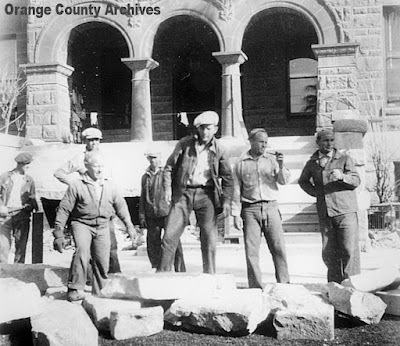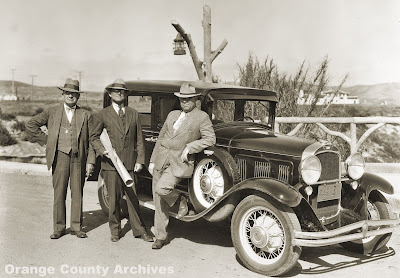 |
| John S. Smythe (ca 1890) and the Orange County Courthouse (ca 1903) |
Who was the first nut to vandalize County property? It's hard to be sure, but we have a strong contender.
In the early hours of Saturday, July 9th, 1903, once-prominent Anaheim pioneer, 79-year-old John Sydney “Fritz” Smythe, mounted a dramatic one-man assault on the Orange County Courthouse. Fritz was the husband of Maria Antonia Josefa Yorba de Smythe of the locally famed Yorba family, and was the father of both Mrs. Fred Rimpau of Anaheim and of the first Orange County Assessor, Frederick C. Smythe.
Fritz had been hanging around the then-newish Orange County Courthouse for a couple days, requesting admittance to Orange County Hospital. But the County Hospital was a service reserved for the indigent. Fritz was told he didn’t qualify because his family was well-off and had explicitly told the county that they were willing and able to care for him themselves. In any case, it seems Fritz’ problems were largely in his brain, which isn’t something a hospital could do much about in 1903.
A quick aside about the hospital: Two years earlier, the County began renting a “hotel” building on Second St. in Santa Ana to use as the County Hospital. Prior to that, the building had been operated by madam Mary “Glass-eyed Mollie” Wright. By 1903, however, the only remaining unorthodox aspect of the place was that Wright’s father, “Mysterious Bill,” was still living in a shack on the property.
In any case, Fritz was furious about being turned away. In fact, he didn’t seem to care which County agency institutionalized him. The makeshift hospital and the jail were similarly appealing to him.
"An honest man has no chance in this county," Fritz complained to bystanders. "A man has to be a criminal before getting anything to do in this county," he said, gesturing toward a chain-gang of vagrants on maintenance detail on the Courthouse grounds.
 |
| Prisoners used as labor on the Courthouse grounds many years later -- cleaning up after the 1933 earthquake. |
At 4:15 a.m. that Saturday, Fritz performed what the Anaheim Gazette called a “ghost dance” on the front lawn of the red sandstone courthouse and then proceeded to throw large, carefully selected rocks through ten of the big, expensive windows on the front (south side) of the building. One wonders if the stones were taken from the cobble curbing still found along sections of the Courthouse Block. Casualties included windows in the offices of the Assessor, Tax Collector, and Board of Supervisors.
 |
| Stone curbing on the Courthouse Block, 2025. |
The sound of breaking glass awakened Courthouse janitor George Benedict, who lived in an apartment near the south door on the ground floor. He initially assumed that the building’s large skylight had been broken. But then crash after crash after crash indicated that the whole building was under attack.
 |
| Detail of basement (ground floor) plans for Orange County Courthouse, circa1900. |
Benedict threw on some clothes, dashed to a good vantage point, saw what appeared to be a mad man hurling rocks at the building. He went back for his gun. By the time he got outside with his gun, Fritz Smythe was done with his tantrum and was sauntering off the Courthouse grounds.
Benedict went to awaken Sheriff Lacy, whose apartment in the County Jail, which – being behind the courthouse – may have been out of earshot from the breaking glass.
 |
| The County Jail (a.k.a. "Lacy's Hotel"), behind the Courthouse. |
Lacy caught up with Smythe little more than a block from the Courthouse, in front of the Fashion Livery (419 N. Sycamore), where the Ramona Building now stands. There, Fritz freely admitted to his vandalism spree. He was arrested and examined on a charge of insanity. There was talk of sending him to an asylum. According to the Los Angeles Times, he appeared "unexcited and rational" but also "peculiar, and his manner suggestive of a restrained irrationality."
 |
| Looking down Sycamore from the Courthouse cupola, early 1900s. Fashion Livery, where Smythe was apprehended, highlighted in green. |
On Easter morning, 1899, Fritz had lobbed several rocks through the plate glass windows of Samuel S. Federman’s dry goods store in Anaheim, which had apparently offended him in some way. In that instance, his friends and family ponied up the money to pay for the damage and charges were dropped. How the Express drew the conclusion that this incident was proof of Smythe’s sanity is a mystery.
 |
| Federman's Store is on the right, behind the white horse. View is Center St., looking west from Claudina, Anaheim, circa 1901. |
Fritz was tried for malicious mischief on July 11th for his early-morning Courthouse escapade. Again, some of his friends came forward in court, offering to smooth things over by paying for the windows. But this time, when they found out what the windows would cost (at least $140), they rescinded their offers and left Fritz to the tender mercies of the law. Perhaps they also hoped a little punishment might discourage yet more window-breaking escapades.
Fritz was sentenced to six months in County Jail, which must have pleased him. Due to his advanced age, he was not put on the chain-gang as he’d pined for. But he proved a “good prisoner” and requested only one meal (breakfast) each day.
The appeal of jail life wore thin, however. In December he formally appealed for early release for good behavior. The Board of Supervisors said they’d agree to early release if he, in turn, would agree to leave the county. But Smythe refused and served the rest of his sentence, which ended in the middle of January.
John S. “Fritz” Smythe appeared to still be in relatively good heath when he died of sudden heart failure June 22, 1906 at his home in Anaheim.
 |
| The Orange County Courthouse, including new windows, circa1904 |
The problem of lunatics creating headaches in and around what's now called the Old Orange County Courthouse is still with us. Having spent decades in Downtown Santa Ana, I’ve seen a LOT of crazy, heartbreaking, and destructive behavior from the homeless, the vast majority of whom suffer from serious mental illness, drug addiction, or both. I’ve seen way more than my fair share of screaming/unintelligible rants, endless wacky conspiracy theories, sidewalk poop, attempted arson, prone human forms that might or might not be dead, scattered drug paraphernalia, shockingly creative property damage, and so much more. And I’ve seen the Old Courthouse – now a beloved historical landmark and iconic symbol of our county – defaced (and repaired) many times.
 |
| The crowd surrounding the Old Courthouse in the late 2010s and early 2020s. |
In a move Smythe would have appreciated, there have even been many windows broken at the Old Courthouse and other civic buildings in recent years. At the time, I didn't recognize these incidents as historical re-enactments.
The situation is much better than it was in the late 2010s and early 2020s, but it's still part of daily reality. Just one example is a person I see frequently who's given to writing paranoid screeds on public property. She claims she lived on Mars for three years, trained Queen Elizabeth’s horses, and brought down mob kingpins for J. Edgar Hoover. Presumably not simultaneously, but who knows?




.jpg)
